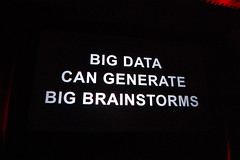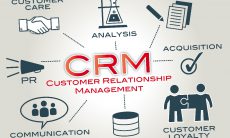“Big Data” is shorthand for the collection of large amounts of data from places like web-browsing data trails, social network communications, sensor and surveillance data that is then searched for patterns, new revelations and insights. It’s a catchy term that’s easy to say and implies major transformation. In less than a decade, Big Data is a multi-billion-dollar industry.

Consider these facts:
- 91% of marketing leaders believe successful brands use customer data to drive business decisions (source: BRITE/NYAMA)
- 90% of the world’s total data has been created just within the past two years (source: IBM)
- 87% agree capturing and sharing the right data is important to effectively measuring ROI in their own company (BRITE/NYAMA)
Is Big Data working? Here are 6 case studies that show how Big Data is helping companies make better decisions.
- HERTZ: With over 8300 locations worldwide in 146 countries, Hertz keeps its finger on the pulse of its customers with customer satisfaction. The problem? How to collate the information and understand what customers were trying to tell them through these surveys? By applying advanced analytics solutions, the company was able to process the information much more quickly–in half the time it previously took, while at the same time providing a level of insight previously unavailable to the company. An example? While evaluating the solution, Hertz was able to identify a potential area for improvement in Philadelphia: surveys and measurements indicated that delays were occurring for returns during specific times of the day. By investigating this anomaly, Hertz was able to quickly adjust their staffing levels at the Philadelphia office during those peak times, ensuring a manager was present to resolve any issues. This enhanced Hertz’s performance, and increased customer satisfaction…all by parsing the volumes of data being generated from multiple sources.
- HOLLYWOOD BOX OFFICE RETURNS: It’s one of the great mysteries that movie studios face: how well will their next release do in the box office? To date, the answer to that question has been a lot of guesswork, and “gut checks”. But with the advent of social media sites, as well as big data analytics, for the first time, studios have a way to measure sentiment by accessing multiple big data sources. The solution: Examine how social media data feeds could be analyzed in order to better understand public sentiment. Initially the idea was to track social movements using social media tools. The ability to understand how the public perceives a specific movie could go a long way towards informing the studio as to the efficacy of its marketing efforts, as well as the ability to better encourage interest. It, of course, could also give studios additional insights to help inform go/no-go decisions on everything from the breadth of distribution to whether it made sense to invest additional marketing muscle to push a movie over the public’s awareness tipping point.
- T-MOBILE: Has integrated Big Data across multiple IT systems to combine customer transaction and interactions data in order to better predict customer defections. By leveraging social media data along with transaction data from CRM and Billing systems, T-Mobile USA has been able to “cut customer defections in half in a single quarter.”
- SETON HEALTHCARE: Sought to address a need to reduce the occurrence of high cost Congestive Heart Failure (CHF) readmissions. How would Seton do this? By proactively identifying patients likely to be readmitted on an emergent basis, they applied predictive models and examined analytics through which providers can intuitively navigate, interpret and take action. The benefit? For Seton, a reduction in costs and risks associated with complying with Federal readmission targets. For Seton’s patients, fewer visits to the hospital and overall improved patient care. Seton is able to identify patients likely for re-admission and introduce early interventions to reduce cost, mortality rates, and improved patient quality of life.
- US XPRESS: A provider of a wide variety of transportation solutions, collected about a thousand data elements ranging from fuel usage to tire condition to truck engine operations to GPS information, and uses this data for optimal fleet management and to drive productivity. As a result, they save millions of dollars in operating costs each year than before they applied data, measurement and analytics were used for this purpose.
- H&R BLOCK: Has learned in the weeks prior to April 15th, every question that is not answered immediately is a lost sale. Tax preparation is a highly seasonal business. H&R Block had a heavy paid media scheduled but they also used Facebook and Twitter to provide immediate access to a tax professional for Q&A in the “Get It Right” social media campaign. The effort secured 1,500,000 unique visitors and answered 1,000,000 questions for a 15% lift in business versus the prior year when there was no social media in the marketing mix.
If you’d like to know more about the impact of Big Data, here are 38 big facts on Big Data every business leader should know.
Do these case studies convince you Big Data is helping companies make better decisions?









